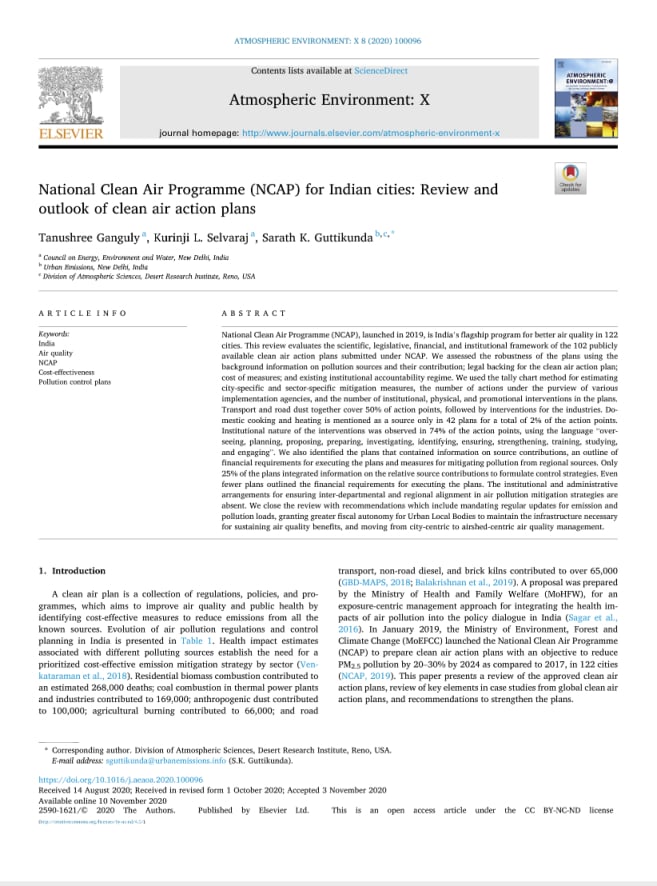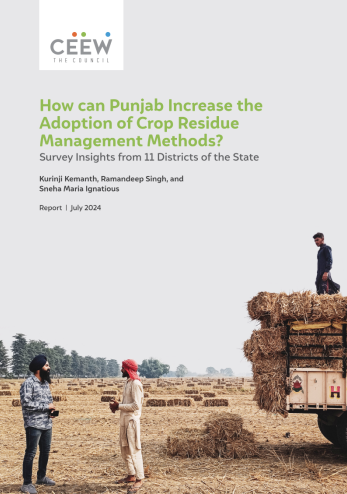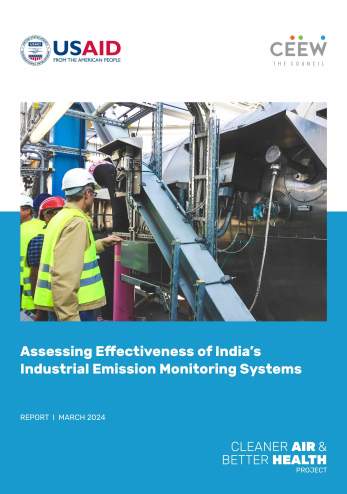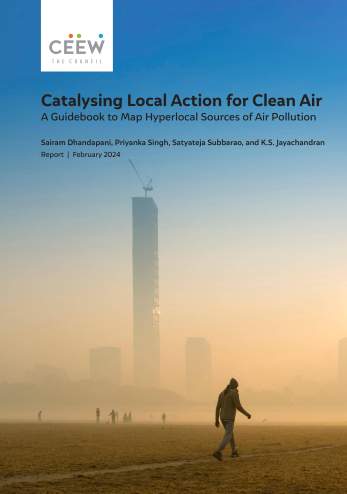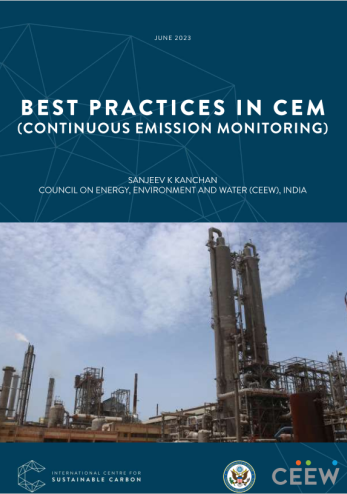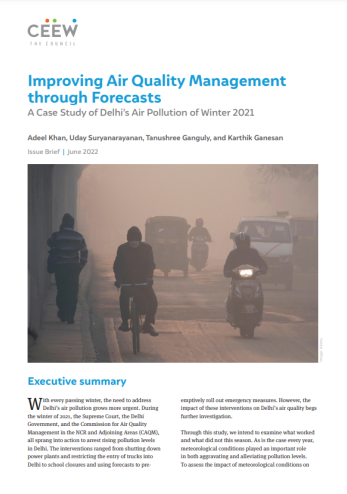Paper
National Clean Air Programme (NCAP) for Indian cities
Review and outlook of clean air action plans
Tanushree Ganguly, L. S. Kurinji, Sarath Guttikunda
December 2020 | Clean Air
Suggested citation: Ganguly, Tanushree, Kurinj L. Selvaraj, Sarath K. Guttikunda. 2020. “National Clean Air Programme (NCAP) for Indian cities: Review and outlook of clean air action plans.” Atmospheric Environment: X, Vol 8 . https://doi.org/10.1016/j.aeaoa.2020.100096
Overview
This paper evaluates the scientific, legislative, financial, and institutional framework of the 102 city-specific clean air plans in India approved under the National Clean Air Programme (NCAP). It assesses the robustness of the plans based on key components such as the background information on pollution sources and their contribution, legal backing for the clean air action plan, costs of implementing measures, and the existing institutional accountability regime. Further, it provides recommendations on improving the plans and air quality management in the 102 cities. The paper comes on the back of the CEEW-Urban Emissions study ‘How Robust are Urban India’s Clean Air Plans? An Assessment of 102 Cities’.
The study uses a tally chart method for estimating city-specific and sector-specific mitigation measures, the number of actions under the purview of various implementation agencies, and the number of institutional, physical, and promotional interventions in the plans.
Key Highlights
- Maharashtra has the most non-attainment cities (18) followed by Uttar Pradesh (15).
- Odisha with six non-attainment cities and an average of 118 action points per city has the longest list. Karnataka with four cities and an average of 29 action points per city has the shortest list.
- Transport and road dust together cover 50 per cent of action points, followed by interventions for the industries. Domestic cooking and heating is mentioned as a source only in 42 plans for a total of 2 per cent of the action points.
- Institutional nature of the interventions was observed in 74 per cent of the action points, using the language “overseeing, planning, proposing, preparing, investigating, identifying, ensuring, strengthening, training, studying, and engaging”.
- Only 25 per cent of the plans integrated information on the relative source contributions to formulate control strategies. But this information does not translate into prioritising actions listed in the plan.
- The absence of source information has resulted in plans being replicated for the cities within a state. Nine states with multiple non-attainment cities have used the same set of action points and timelines across all cities.
- Only 48 cities in eight states have prepared clean air plans with distinct actions and interim targets
- Apart from Delhi's clean air plan, which the Supreme Court notified for implementation in January 2018, no other clean air plan has binding obligations for implementation.
- Only 24 per cent actions were allotted to the pollution control boards.
- About 60 percent actions fall under the urban local bodies (ULBs), including municipal corporations, development authorities, transport department, and the traffic police.
- Disproportionate allocation of activities to ULBs is problematic due to India's underdeveloped municipal finances.
- Estimates suggest that 30 per cent of the PM 2.5 concentration comes outside the boundary, highlighting the need for more regional collaboration for cleaner air. While most city plans include the recommended measures, there are no clear guidelines on establishing regional coordination.
- Evaluating the cost-effectiveness of the control measures is critical for an effective CAP with prioritised actions to reach the clean air targets.
- Even fewer plans outlined the financial requirements for executing the plans.
- The institutional and administrative arrangements for ensuring inter-departmental and regional alignment in air pollution mitigation strategies are absent.
- Only 10 cities (seven cities in Maharashtra, two cities in Nagaland, and one city in Telangana) listed budgetary requirements for executing their plans.
Key Recommendations
- Mandate regular updates for emission and pollution loads. This will automatically help address the information gaps to support planning, tracking progress, and evaluating impacts of interventions.
- Move from city-centric to airshed-centric air quality management. This approach requires an inter-state coordination mechanism, which can be facilitated by setting up regional airshed management authorities that enjoy cross-state jurisdiction.
- Grand greater fiscal autonomy for Urban Local Bodies to maintain the infrastructure necessary for sustaining air quality benefits.
- Responsible agencies should identify key indicators that could be tracked to monitor the impact of the interventions.
- Delineate responsibilities -- planning, implementing, enforcing, monitoring -- for each recommended measure across participating agencies and avoid overlaps.
Only 25 per cent of the city clean air action plans integrated information on the relative source contributions to formulate control strategies.




